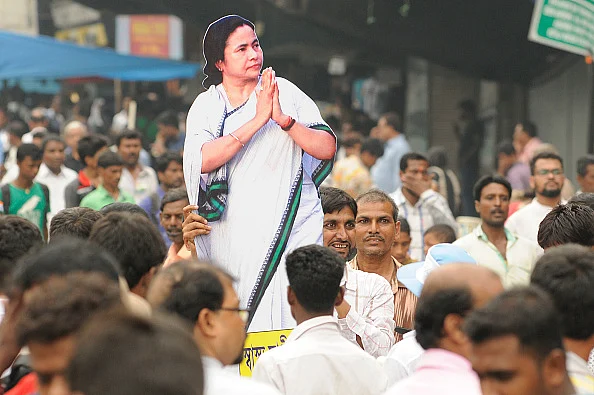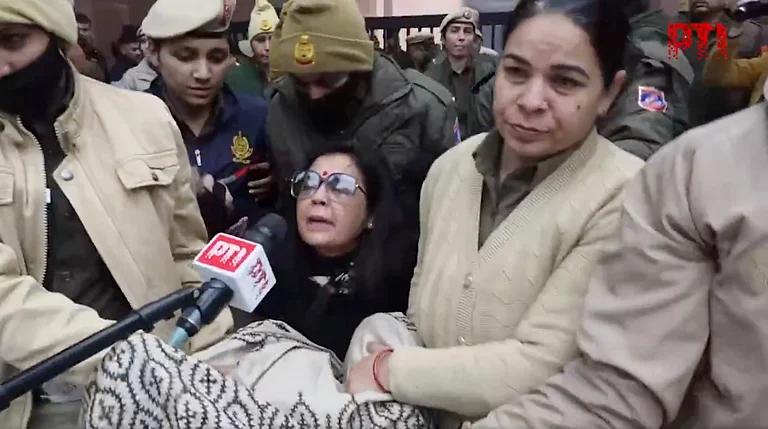Trinamool Congress, formed at the threshold of the new millennium, has seen a two-decade trajectory from a split faction of the Congress to the biggest party in West Bengal with Mamata Banerjee showing the way. Despite its ideological ambiguity and glaring fissures, the party with its significant momentum, was successful in appealing to a wide cross-section of voters especially women and farmers, in the presence of a left government, and has been successful in dismantling robust strongholds across the state and beyond.
Outlook looks at the timeline of the Mamata Banerjee party.
1998: Mamata Banerjee and Mukul Roy leave Congress over differences and form the All India Trinamool Congress. Quickly rose to prominence, winning seven seats in the 1998 Lok Sabha Elections, getting into the BJP-led NDA.
1999: Wins eight seats in the 1999 Lok Sabha elections in alliance with BJP, gaining significant traction among leaders and the people of West Bengal. A part of the NDA, Mamata Banerjee becomes the Railway Minister for the first time.
2000: TMC wins the Kolkata Municipal Corporation Elections in alliance with BJP, and the support of the Indian National Congress, ending Left Front’s fifteen year-hold on the KMC elections.
2001: The party wins an impressive 60 seats in the 2001 West Bengal Assembly elections, having ended ties with NDA and allied with the Congress, becoming the primary opposition in the state. It marks the first time since 1971, no party is able to secure an absolute majority and the first time since 1977, that the CPIM fail to secure a majority of its own.
2004: TMC underperforms at the 2004 Lok Sabha elections, under the NDA banner, winning a meagre two out of the 31 seats contested across West Bengal, Meghalaya and Tripura. Having joined the NDA back in 2003, Mamata Banerjee and close aide Sudip Banerjee are made part of the cabinet, with Banerjee taking the Coal and Mines portfolio.
2005: TMC loses crucial Kolkata civic polls, with sitting Mayor and credible TMC face Subrata Mukherjee defecting to NCP ahead of the polls. TMC protests intensify against CPIM’s industrial projects including handing over farmland in Howrah to Salim group.
2006: The NDA plan backfires for TMC. The party fails to retain almost half of the seats won in the 2001 Bengal Vidhan Sabha Elections. Mamata Banerjee hurls resignation papers at deputy speaker Charanjit Singh Atwal and leaves the NDA. Singur Protests gain momentum as CPI-M government announces land for Tata project. Banerjee, calls for an indefinite hunger strike and leads protests with farmers facing the threat of displacement.
2007: CPI-M’s decision to create a chemical hub with the Salim Group in the Nandigram Special Economic Zone (SEZ) needed land, leading to the displacement of the farmers and their families. Protests lead to violence with 14 people allegedly killed by the police with allegations of torture and rape by ruling party cadres coming to the forefront. TMC leads the protests against the CPIM government, drawing national attention with the call of ‘Maa, Mati, Manush’, which would eventually become the electoral slogan for the party in the following elections.
2009: Re-joins the Congress-led UPA before the 2009 Lok Sabha Elections, and lands a great performance with the alliance winning 26 seats in Bengal. Mamata begins her second stint as Railway Minister in the UPA government.
2010: Wins the Kolkata Municipal Corporation polls emphatically securing 97 out of 141 seats, and a spate of crucial municipal polls in others places, setting the prelude to the 2011 Vidhan Sabha Elections.
2011: TMC, in alliance with INC and SUCI, ends the thirty-four year Left Front Rule in West Bengal, coming to power in the state by winning 227 seats and TMC securing 187 seats alone, enabling it to run the state without an alliance. Mamata Banerjee sworn in as the first female Chief Minister of the State. Announces the return of 400 acres of land to Singur farmers as one of the first decisions. Quits as the Railway Minister.
2012: Withdraws support to the UPA over unmet demands.
2014: Performs dominantly in the 2014 Lok Sabha polls, winning 34 out of 42 seats in Bengal. Qualifies for national status, securing 6 per cent votes from five states: WB, Manipur, Tripura, Assam and Jharkhand. Saradha Group financial scandal exposed. Following CBI investigation numerous TMC leaders including Madan Mitra, Kunal Ghosh and Srinjoy Bose face serious accusations of money laundering in multi-crore rupees scam. A period marred by multiple accusations of financial embezzlement.
2016: TMC wins the West Bengal Assembly elections, securing an overwhelming majority of 211 out of 293 seats, becoming the first ruling party to win in West Bengal without an ally since 1962. TMC is recognised as a national party by the Election Commission of India. A sting operation led by a senior investigative journalist brought allegations of Narada scam to the forefront with MPs like Mukul Roy, Sougata Roy, Kakoli Ghosh Dastidar, Madan Mitra, Firhad Hakim caught taking alleged monetary bribes in exchange of favours on camera.
2017: Mamata Banerjee launches Kanyashree, a defining initiative taken to help economically backward families with cash so that they are nor forced to marry their girl child off, before eighteen years of age. With the aim of uplifting and empowering young girls, the initiative was recognised by the United Nations Department of International Development and UNICEF.
2019: In the 2019 Lok Sabha Elections, TMC secures 22 seats, giving way to BJP to gain considerable ground in the state for the first time, with 18 seats.
2021: Wins the Vidhan Sabha elections for the third time, securing a landslide two-thirds majority winning 215 seats. Popular party faces Suvendu Adhikari and Mukul Roy defect to BJP just before the assembly elections. Mamata Banerjee swears in as CM, winning a by-election from Bhawanipur, after a loss against Adhikari in Nandigram. Launches popular schemes like Lakshmi Bhandar and Student Credit Card Scheme.
2022: Cabinet Minister and senior leader Partha Chatterjee, who served as the Minister of Education, arrested, and other leaders including Mamata Banerjee’s nephew Abhisek Banerjee and Sayoni Ghosh questioned by ED in connection with the alleged School Service Commission Recruitment Scam case. Noted TMC leader from the Birbhum district, Anubrata Ghosh arrested by CBI in a cattle smuggling case.
2024: Becomes an active face of the opposition Congress-led INDIA bloc against the NDA in the run-up to the upcoming 2024 Lok Sabha polls. In February 2024, women in the Sandeshkhali village of West Bengal come forth with accusations of assault and rape against local TMC leader Sheikh Shahjahan, Uttam Sardar and Shibu Hazra. Shahjahan was arrested by the ED and Mamata Banerjee faced immense flak for being unable to deal strictly with such people within the party and failing to take strict actions on a swift note.











 and Rahul Gandhi (R)?auto=format%2Ccompress&fit=max&format=webp&w=376&dpr=2.0)













